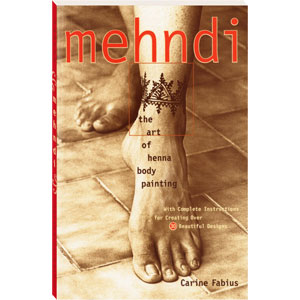About Henna
INTRODUCTION
Earth Henna® is a unique, all-natural henna mix that was created to simplify the centuries-old application process into easy-to-use henna kits. Once mixed, Earth Henna paste lasts four weeks, if refrigerated; and proper staining of the skin is achieved in just 6 hours! If you’re not artistically inclined, our Earth Henna Tattoo Kits feature beautiful stencil sheets to help you create perfect henna designs in just minutes.
On this page you can learn all about henna and its unique properties. (See also our Henna FAQs.)
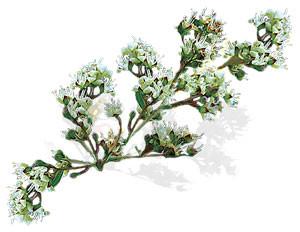
Henna Flower
History
For centuries, mehndi—the art of henna painting on the body—has been practiced in India, Africa, and the Middle East, where the henna plant is believed to bring love and good fortune, and to protect against evil. Mehndi is traditionally practiced for wedding ceremonies, during important rites of passage, and in times of joyous celebration. A paste made from the crushed leaves of the henna plant is applied to the skin, and when removed several hours later, leaves beautiful markings on the skin that fade naturally over 1 to 3 weeks.
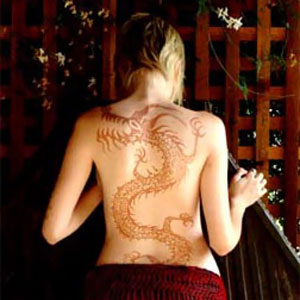
Henna has been used throughout Africa, India,
and the Middle East for thousands of years.
Henna Use in the Past
Besides being the key ingredient in mehndi, henna has also been used to dye the manes and hooves of horses, and to color wool, silk, and animal skins, as well as men’s beards. Studies of mummies dating back to 1200 BC show that henna was used on the hair and nails of the pharaohs. Once the henna plant’s cooling properties were discovered, painting the skin became a way for the desert people of India to cool down their body temperatures.
Henna Today
Until the art of mehndi became hot news in 1996, henna was mostly used in the United States as a hair dye. Widely recognized now as a wonderful way to dye the skin and to achieve the look of a tattoo, traditional henna uses and application processes have gone contemporary. Although some will always prepare their own henna paste, mehndi kits of varying quality, with foolproof instructions and convenient stencils, can be purchased in many retail and online outlets (including this website).
Geography
Practiced for five thousand years throughout India, Africa, and the Middle East, the act of painting the body with preparations made from the crushed leaves of the henna plant, whether it be in preparation for a special occasion or in celebration of a particular event, has always been done with the assumption or fervent wish that the act would engender good fortune, happy results, and good feelings.
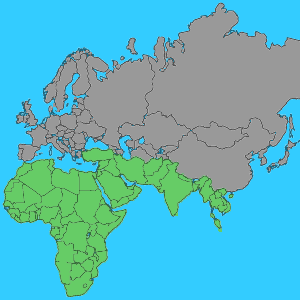
Green portions of this map show areas
where henna has been used traditionally
over the centuries for ceremonies
and personal adornment.
Mehndi in India
In the north and western parts of India, the desert areas where the henna plant grows, mehndi (or henna painting) is a very important part of the wedding ritual and ceremony. As the story goes, the deeper the color obtained on the skin, the longer the love between the couple will last; hence the belief that a proper mehndi application is tantamount to a prayer to the gods for everlasting love and a successful marriage.
Mehndi in Morocco
Pregnant Moroccan women in their seventh month seek out well-respected henna practitioners called hannayas in order to have certain symbols painted on their ankle, which will then be encircled with a corresponding amulet. The henna and the amulet are meant to protect both the mother and child through birth.
Once the baby is born and the umbilical cord severed, a plaster of henna, water, and flour is placed on the newborn’s belly button in order to ensure beauty and wealth.
Botany
The botanical name of the henna plant is Lawsonia inermis. A member of the Loosestrife family, henna originally comes from Egypt, a country that is still one of the main suppliers of the plant, along with India, Morocco, and the Sudan. (We have been buying our all-natural, high-quality henna powder from the same farmer since 1998!)
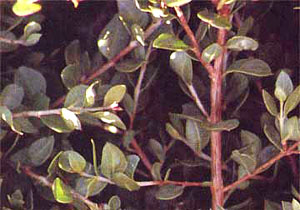
Henna plant (Lawsonia inermis)
Appearance of Henna
Those who have already come into contact with powdered henna are familiar with its undeniably special smell, a powerful and heady combination of earth, clay, chalk, and damp green leaves. In contrast, fresh henna leaves have no odor whatsoever, even when crushed between the fingers.
The henna flower is delicate, petite, and four-petaled, with a profusion of slender and elongated antennas bursting from the center. The red, rose, and white variations of the blossom, which also blooms yellow, cream, and pink, emit a sweet and seductive scent reminiscent of jasmine, rose, and mignonette; hence the name Jamaica Mignonette, as henna is referred to in the West Indies.
Although the plant’s primary uses lie elsewhere, the flower’s oil has been used as a perfume for many centuries (although its fragrant secret has yet to be popularized in the West).
Properties of Henna
In addition to its cooling properties, several other medicinal properties are attributed to henna. It is used as a coagulant for open wounds; and a poultice made with henna leaves works to soothe burns and certain types of eczema.
Its inherent soothing qualities are also part of the reason why mehndi is traditionally performed on the palms of the hands. Since the palm contains numerous nerve endings, when henna is applied to the area it helps to relax the system.
Finally, henna mixed with vinegar and applied to the head is reputed to heal headaches. Aspirin, move over!
Text for this page adapted from
Mehndi: The Art of Henna Body Painting
by Carine Fabius

